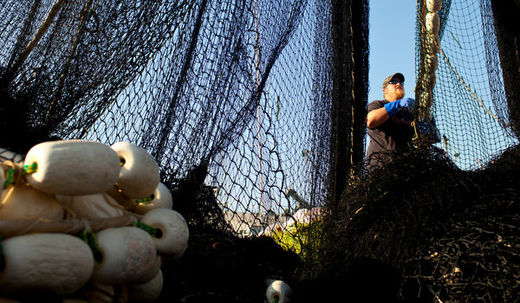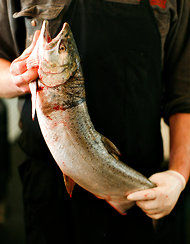
More scientists in Washington started talking, and 24 hours later everyone is asking more questions. As word spread that infectious salmon anemia, a deadly virus that has devastated farmed fish in Chile, had been found for the first time in prized wild Pacific salmon, there remained much uncertainty about the finding and what its potential impact could be.
So far it has been found in just two wild sockeye salmon in British Columbia and not in an active state. Nevertheless the reaction from fishermen has echoed that of some scientists: this is the last thing salmon need.
"On top of everything else, that would just be murder here," said Mr. Tremain, aboard his 40-foot boat, Heidi, at Fishermen's Terminal here.
Multiple species of wild Pacific salmon, which migrate between freshwater rivers and the saltwater ocean, are listed as endangered species, their numbers threatened by declining river habitat, hydroelectric dams, rising water temperatures and other factors.
"Now we have something in the salt water that can kill them, too," said Mr. Tremain, referring to the newly found virus. "With all of the other threats, the ocean has been what's saving them."
Infectious salmon anemia is not contagious to humans, but it has many people here worried. Wild salmon are a cultural symbol, a political wedge, a marketing phenomenon and good eats. A bumper sticker seen often in the region mocks their farmed foils: "Friends Don't Let Friends Eat Farmed Salmon: support your local commercial fisherman."

"Four or five years ago people would ask, 'Why should I not eat farmed salmon?' " Mr. Kristin said. "Now people don't even ask that. Everyone just knows."
Fishermen have long blamed fish farms and hatcheries for hurting their livelihoods, either for bringing down prices at one point or spreading disease to the wild stocks. The new finding has only increased resentment.
"There's nothing good about a fish farm," said Don Koston, who has been providing ice and bait to commercial fishermen for the Seafood Producers Cooperative in Sitka for 20 years.
Richard Routledge, a professor from Simon Fraser University, speculated that the fish may have caught the disease from a nearby fish farm. Canadian officials, however, say the fish at the farm have not tested positive for the disease. That discrepancy has caused some scientists to privately question the validity of the government tests, in part because the same Canadian agency that regulates fish farming, Fisheries and Oceans Canada, also promotes it. The agency did not respond to a request for comment on Wednesday.
At the same time, several scientists in Canada and the United States noted that the test was not conducted on a live culture, which is the standard method, and said the method used was susceptible to false positives. Several said it was possible that wild salmon could carry the disease without contracting it.
Jill Rolland, the director of aquaculture, swine, equine and poultry health programs at the Department of Agriculture, said she did her doctoral work on the impact of the disease on Pacific salmon and found that they had greater resistance to the disease than Atlantic salmon. She also said it was possible that their resistance could weaken.
"Viruses can change over time so you cannot discount that possibility," Dr. Rolland said. "But we have evidence at this time that Pacific salmon are more resistant."



Reader Comments
to our Newsletter